June 22, 2007
Air Date: June 22, 2007
FULL SHOW
SEGMENTS
Will EPA Clear the Air on Smog?
/ Jeff YoungView the page for this story
The Environmental Protection Agency's science advisors say current standards on ozone, or smog, do not protect human health. Will EPA strengthen the standard? Living on Earth's Jeff Young reports. (05:30)
What's Corn Got To Do With It?
View the page for this story
Fertilizer runoff from farms in the Corn Belt is contributing to a growing marine dead zone in the Gulf of Mexico. Host Steve Curwood talks with scientist Don Scavia of the University of Michigan. Professor Scavia thinks he knows how to stop the dead zone...with a little help from the 2007 Farm Bill. (06:00)
Global Warming Games
View the page for this story
Who says global warming can't be fun? The "Xbox 360 Games for Change Challenge" asks college students in 100 countries to come up with their best video games based upon the theme of global warming. Host Bruce Gellerman speaks with Suzanne Seggerman of Games for Change about using games to help solve our most complex social problems. (05:30)
Seventeen Year Cicada
View the page for this story
After seventeen years of hibernation, the cicadas of Brood XIII in Illinois recently re-emerged. Commentator Tom Montgomery-Fate has been watching them in his backyard in suburban Chicago, with a sense of wonder about their--and our--purpose. (02:40)
Utah River, Frogs Bounce Back
/ Beth HoffmanView the page for this story
In the late 1990s, biologists and hydrologists set about restoring Utah's Provo River. The river had been dammed and forced into channels. Now, nine years later, the river's had a major turnaround, and so has a creature that had all but disappeared - the Columbia Spotted Frog. Beth Hoffman reports. (07:15)
Listener Letters
View the page for this story
We dip in the LOE mail bag to hear what listeners have to say. (02:00)
Emerging Science Note/Orange Cauliflower
/ Lauren CoxView the page for this story
Scientists at Cornell University find the mutation that gives orange cauliflower its color and high nutritional value. As Lauren Cox reports, they hope to use this knowledge to make other crops more nutritious for developing nations. (01:30)
Intrepid Travelers
View the page for this story
Just before he turned forty, author and photographer Marty Essen decided he hadn’t seen enough of the world. So he and his wife set out on a voyage to explore the seven continents and document the creatures they encountered. Essen talks with Bruce Gellerman about his book, “Cool Creatures, Hot Planet; Exploring the Seven Continents.” (05:30)
Eating Locally, Cooking Creatively
/ Ian GrayView the page for this story
Less than one percent of Americans work or live on farms. But a movement called Community Supported Agriculture, or CSAs, give people a chance to buy into a farm for a season and receive fresh fruits and vegetables every week. Food writer Kathy Gunst went with Living on Earth's Ian Gray to pick up his first CSA box of the year, and then took the ingredients to whip up a delectable dinner. (06:30)
This week's EarthEar selection
listen /
download
Songs of the 17-year Cicada.
Show Credits and Funders
Show Transcript
HOST: Bruce Gellerman
GUEST: Marty Essen, Don Scavia, Suzanne Seggerman
REPORTER: Ian Gray, Beth Hoffman, Jeff Young
COMMENTARY: Tom Montgomery-Fate
SCIENCE NOTE: Lauren Cox
[THEME]
GELLERMAN: From Public Radio International - this is Living on Earth.
[THEME]
GELLERMAN: I’m Bruce Gellerman.
The EPA has been under pressure for years to strengthen its smog standards and clear the air of ozone. Now the agency has a plan, but some critics say it’s just a smoke screen.
ODONNELL: We are really concerned that EPA appears to be rolling out the red carpet to industry, inviting them to flood EPA’s mailbox with protests of any change in the current standard.
GELLERMAN: Also, frogs are disappearing from ecosystems around the world. But in Utah, a river restoration project is helping frogs bounce back.
TRAINER: I think if this project hadn’t had come on line, if it would have been going the way it was going before, another generation they wouldn’t even know that they ever even existed. I mean a world without frogs, it’s a sad world.
GELLERMAN: These ribbeting stories and more this week on Living on Earth. Stick around!
[NPR NEWS CAST]
ANNOUNCER: Support for Living on Earth comes from the National Science Foundation and Stonyfield Farm.
Will EPA Clear the Air on Smog?

(Courtesy of United States Geologic Survey)
GELLERMAN: From the Jennifer and Ted Stanley Studios in Somerville, Massachusetts - this is Living on Earth. I’m Bruce Gellerman.
Ozone is a nasty gas that forms when pollutants from tailpipes and smokestacks cook in the sun. It’s the main component of smog and it contributes to all sorts of health problems — lung, cardiovascular disease — it can even kill you.
A science advisory board recently told the Environmental Protection Agency to strengthen its standards for ozone pollution, and the Administrator of the EPA has just announced his decision. But as Living on Earth’s Washington correspondent Jeff Young tells us, it hasn’t exactly cleared the air.
YOUNG: It’s been ten years since the EPA last set standards for ozone. The American Lung Association’s Janice Nolen says numerous studies in the past decade show that the old standard is not protecting the public from smog.
NOLEN: Ozone acts like a sunburn on the lungs, it is an irritant. It sends people to the hospital emergency room, it triggers asthma attacks and now we’re learning recent studies have indicated it can actually shorten life.
YOUNG: The current standard for ozone is 80 parts per billion—parts per billion is a measure of the molecules in the air. The 22 independent members of EPA’s Clean Air Science Advisory Committee reviewed the issue and reached a unanimous decision. In March the advisors told EPA Administrator Stephen Johnson there was no scientific justification for keeping the current standard. They recommended strengthening it to protect health with an adequate margin of safety. Johnson says he agrees.
JOHNSON: As a 26-year scientist and based upon the current science, the current standard is insufficient to protect public health. That’s why I propose to toughen the standard.
YOUNG: Johnson proposes an ozone standard somewhere between 70 and 75 parts per billion. That’s tighter than the current one, but barely in the range his science advisors recommended. Science Advisory Committee Chair Dr. Rogene Henderson says her committee wanted a stronger level, somewhere between 60 and 70.
HENDERSON: I think it’s a step in the right direction and we’d like for the step to be a little bigger step, but at least it’s in the right direction.
YOUNG: Other public health advocates see the EPA proposal as more of a sidestep than step ahead. That’s because in addition to his proposal to strengthen the standard, Johnson also said the EPA will still accept comments on keeping the standard where it is.
JOHNSON: I want to provide an opportunity both on the upper end of scale, and on the lower end of the scale, to provide comments so that the agency will have all information on which to base an informed decision and a final.
YOUNG: The lung association’s Nolen calls that disappointing.
NOLEN: There is no basis in any evidence that we’ve seen for keeping the existing standard so why would it even be on the table?
YOUNG: Frank O’Donnell at the advocacy group Clean Air Watch thinks the answer to that has to do with the industry lobbyists who visited the White House in the weeks just before EPA’s announcement—firms representing the chemical, power and auto industries all weighed in.

Ground level ozone smog in Los Angeles (Courtesy of United States Geologic Survey)
O’DONNELL: We are really concerned that EPA appears to be rolling out the red carpet to industry, inviting them to flood EPA’s mailbox with protests of any change in the current standard
YOUNG: The ozone decision comes in the wake of another bruising clean air battle last year. O’Donnell says EPA bowed to industry pressure then when administrator Johnson ignored his science advisors on the Clean Air Standard for fine particulate matter. O’Donnell says the ozone decision is looking like another test of the administrator’s will.
O’DONNELL: Well I think that the EPA’s proposal reflects a conflict between science and politics that is yet to be resolved.
YOUNG: Industry groups make it clear they want the ozone standard to stay right where it is.
BRENDLE: We’re just not in agreement with whatever it is that the EPA scientists have decided.
YOUNG: That’s Bryan Brendle with the National Association of Manufacturers. Brendle says most of the country’s major metropolitan areas are still struggling to meet the old ozone standard. A new, stricter one would mean hundreds more counties out of compliance and more businesses facing regulation and higher energy costs.
BRENDLE: If you’re a manufacturer, a power producer or some sort of producer of energy such as a refinery you will be subject to major air emissions controls. Those costs are passed on to consumers of electricity.
YOUNG: Clean air advocates counter that ozone pollution acts like a hidden tax on the public, pushing up health care costs. EPA will hear plenty from both sides in the coming months. It’s taking public comment for 90 days and scheduling hearings in late summer in some of the country’s smoggiest cities: Los Angeles, Philadelphia, Atlanta and Houston. The Agency’s final decision is due by March 2008. For Living on Earth I’m Jeff Young in Washington.
[MUSIC: The Roots “The Seed (2.0)” from ‘Phrenology’ (MCA Records – 2002)]
Related links:
- EPA's new ozone proposal
- EPA's Clean Air Science Advisory Committee's recommendations on ozone
- Counties State-by-State that the EPA considers would be out of Compliance with the New Standard on Ozone
- Our past coverage of EPA scientists and administrators disagreeing over a new soot standard in 2006
What's Corn Got To Do With It?

In this thermal resonance image, the red colored areas show abnormally large summer blooms of phytoplankton due to high levels of nitrogen run-off in the Gulf. (Courtesy of NOAA)
GELLERMAN: It’s peak growing season in the Midwest corn belt, where they say it’s a good year if stalks are knee high by the fourth of July, but what helps crops grow in the Midwest runs down into the Gulf of Mexico. And that means trouble. Millions of tons of fertilizer used on farms throughout the vast Mississippi watershed run downriver into the gulf, creating a huge dead zone where most marine life can’t survive.
It’s been expanding for decades, but some marine scientists think this year’s farm bill, which Congress is now getting ready to debate, might help bring the dead zone back to life.
Living on Earth’s Steve Curwood recently spoke with Don Scavia. He’s a Professor of Natural Resources and Environment at the University of Michigan, and one of the editors of a new book called “From the Corn Belt to the Gulf.”
CURWOOD: Explain basically, what happens to create a dead zone?
SCAVIA: Well, it’s generally caused by an excess amount of nutrients going into the ocean, or into the Great Lakes. Those nutrients cause algae to grow beyond what the ecosystem can accommodate. The algae will sink to the bottom and decompose and that process of decomposition uses up the oxygen. If that concentration of oxygen gets below the level to sustain fish and organisms that we really care about, we call it a dead zone.
CURWOOD: So, connect the dots here for us, Don. Explain how the run off of nutrients from farms hundreds of miles up the Mississippi get out into the Gulf of Mexico and cause all this.
SCAVIA: Well, agriculture, particularly corn agriculture, is very leaky. You put fertilizer on the ground, a lot of the nitrogen in that fertilizer will get very quickly into the ground water, into the small streams, to the large streams, to the rivers, eventually to the Mississippi River and down into the Gulf. And it’s quite amazing how quickly that water moves from the farm field to the Gulf.
CURWOOD: Now, this isn’t the only dead zone in the world or in America, right?
SCAVIA: That’s right, there are dead zones caused by the same sort of process around the world. The Baltic Sea is probably the largest one. The Gulf of Mexico is the second largest in the world. But in the United States, half of our bays and estuaries have the same sort of problem. Even Lake Erie. The dead zone in Lake Erie that we thought we had solved decades ago has returned. So it’s a problem around the country.

In this thermal resonance image, the red colored areas show abnormally large summer blooms of phytoplankton due to high levels of nitrogen run-off in the Gulf. (Courtesy of NOAA)
SCAVIA: The attention there has come from a recent law that was passed to actually do an analysis and develop an action plan for it. And a lot of that was driven by the concern that the fisheries, particularly the shrimp fishery which could be somewhere between half and three quarters of a billion dollar-a-year fishery, may be at risk if this dead zone continues or in fact may grow in the future.
CURWOOD: So, how can farmers grow the food we need without adding to this problem downstream?
SCAVIA: Farmers can grow their crops in ways that are beneficial to the environment. If we were to put in and actually subsidize farmers to put in buffer strips between their crops and the streams, to encourage the construction of wetlands, to incentivise farmers to use only the amount of fertilizer they need and no more, to do precision farming. There are a number of ways to actually keep the nitrogen on the land. And once it gets into the water, to actually remove it from the water before it gets into the Gulf. And all we really do need in order for that to happen is for the farm bill to put funds into those kinds of conservation measures to help enable the farmers to do that.
CURWOOD: Now, there’s a lot of buzz about farm-based fuels, particularly ethanol. A lot of folks are growing corn in response to the demand for ethanol. How does this problem figure into that, and how do you think the farm bill could make things better under such a scenario?
SCAVIA: Well, there’s no question that growing more corn to supply the ethanol demand, not only increases the price of corn but it’s going to increase the amount of nitrogen getting into the Gulf of Mexico and most likely increase the size of the dead zone. So, that’s going to happen unless there are incentives in the farm bill to move away from corn-based ethanol and into cellulosic ethanol.
CURWOOD: Cellulosic ethanol doesn’t really exist yet, I mean the inventions aren’t quite together. The technology doesn’t quite work yet.
SCAVIA: That’s right and I think hopefully the farm bill could provide research funding in technology and development, and even infrastructure development to look at not just switch grass but wood products and others to get there. We know how to do corn-based ethanol. We don’t know quite how to do the cellulosic yet, but that is really what we need to move towards if we’re going to be concerned about the environment.
CURWOOD: Don Scavia you’ve been working on this for what, the last 30 years?
SCAVIA: That’s right.
CURWOOD: So, from your perspective what now do you think are the prospects for change?
SCAVIA: I think the prospects might actually be better in this farm bill than in the past. I’m hoping that the environmental dimensions to the problem have become more acute and more obvious to those who are developing that policy. There are also international trade dimensions to it. The Europeans and others are not particularly pleased with U.S. subsidies, the way they’re done now. They’re trying to push more to subsidize conservation as opposed to production. So, I think there are pressures and dimensions in new ways that haven’t been there before that gives me some hope that this farm bill might be the way forward for us.
I’m always optimistic. I always think that we can do it. When we dealt with a very similar kind of problem in the small lakes and rivers in the ’60s and ’70s, there was enough motivation and willpower and funding to solve that problem. We’re just working on a larger scale now and it takes longer.
CURWOOD: Thank you so much, sir.
SCAVIA: You’re very welcome.
[MUSIC: Charlie Haden & Hank Jones “Wade In The Water” from ‘Steal Away’ (UMG Recordings – 1994)]
GELLERMAN: Don Scavia is one of the editors of the new book “From the Corn Belt to the Gulf.” He spoke with Living on Earth’s Steve Curwood.
Related links:
- NASA Dead Zone site
- Resources for the Future Report on Dead Zones
Coming up: turning climate change into serious fun and games. That’s just ahead, on Living on Earth.
Global Warming Games
GELLERMAN: It’s Living on Earth. I’m Bruce Gellerman. Video games are serious business.
[MUSIC: Anonymous “DOOM3 Game Preview & Music Theme” from ‘DOOM3 Video Game’ (Id Software – 2006)]
GELLERMAN: Americans spend over seven billion dollars a year on digital games. Most games like this one, DOOM3, offer death and destruction as entertainment. But a non-profit organization believes gamers can have serious fun while addressing serious social problems.
Over the past four years Games for Change has developed games about race and poverty, war and elections. Now, the company is hoping to develop games that can tackle perhaps the biggest issue of our time, global climate change. Games for Change is teaming up with Microsoft, makers of the Xbox, to launch a worldwide competition for college students. It’s called the "Xbox 360 Games for Change Challenge," and it’s offering hefty cash prizes and other goodies for the best video games based on the theme of global warming.
Suzanne Seggerman is the co-founder of Games for Change. We interrupted her fun and games while on vacation in Michigan. Suzanne, I apologize but thanks for joining us.
SEGGERMAN: Great to be here.
GELLERMAN: I was looking online and it says that this is a competition that’s billed as a serious game initiative. And it sounds like an oxymoron.
SEGGERMAN: Yeah, I can understand why people think that. I think games have been seen as only having content that is juvenile or trivial. And actually games are simply a young medium. It’s taken a while for them to quote-un-quote grow up. These games, the games for change, have real world impact in mind. Hopefully, these games encourage players to take action in the real world around the most pressing issues of our day.
GELLERMAN: Well, how can you use a game to address a complex societal issue?
SEGGERMAN: Well, in fact games are fantastic for exploring complex issues. I think they’re better than film or TV where you really are just a consumer of information. They’re good for allowing a player to put themselves in a role, in a perspective that they can’t otherwise have access to. And they’re really great for letting people interact with various systems and different variables. And what could be more complex than the environment?
GELLERMAN: My kids have a game called SimCity and they really enjoy it and I have to say that I really enjoy it. You get to simulate the entire environment. But it has nothing to do with global warming.
SEGGERMAN: Well, it’s interesting that you brought up SimCity because I think in some ways, SimCity is the earliest game for change. Though, that wasn’t what Will Wright intended when he made it. He has since talked to me and told me that SimCity has spawned hundreds and hundreds of urban planners for instance. People really took to that game and it did have a positive impact in the world by inspiring a whole generation of urban planners. Think about how this next generation of kids could be inspired to be environmentalists and humanitarians. You know I’d like to see also, a thousand little game seeds planted. Not all the games are going to get prizes and not even that many are going to get recognized. But think of this new generation of game-makers and game innovators we’re reaching. All these kids who’ve perhaps never even considered the impact of the environment are going to be getting knee deep in environmental issues. That’s really exciting. You know kids really respond to this medium of video games in a way they don’t to a newspaper or a heavy documentary. And I think that’s the key. It’s that we’re reaching them on their own turf.
GELLERMAN: So, do you envision games for example that might have somebody managing an airline’s foot print or dealing with rising temperatures in a corn field in the Midwest?
SEGGERMAN: Absolutely. Bruce are you going to sign up for the contest? I hope so. Those are great ideas.
GELLERMAN: (laughing) Do you have an idea that you might submit?
SEGGERMAN: Oh, I’m a judge. I’m not allowed. You know it’s going to be exciting because I like to see games about the environment go across the spectrum. On the one hand, we could have really playful games about any number of subject matter. And on the other, you could get very serious about the complex nature of these interrelated systems about the environment.
GELLERMAN: And this is a worldwide competition. How many people do you think might compete in the contest?
SEGGERMAN: We’re aiming to reach 100,000 students with the opportunity to participate.
GELLERMAN: What does the winner get?
SEGGERMAN: There are a number of prizes, cash prizes. The first prize winner gets $25,000 towards an educational scholarship. The second prize is 15 (thousand) and the third prize is 10 (thousand). But the prize I think is most exciting is that, the winning team gets to show their prize to the Microsoft game management team and have that game possibly go up against all the games on the XBox live, which is an audience of six million players. There’s also a chance for the winning team to become interns on the Microsoft game team. That’s another really invaluable opportunity.
GELLERMAN: Well, Suzanne, I want to thank you very much.
SEGGERMAN: Thank you so much for having me. It was great to talk.
GELLERMAN: Suzanne Seggerman is the co-founder of Games for Change. The “Xbox 360 Games for Change Challenge” starts in August. You can find a link to Games for Change on our web site, LOE dot org.
[MUSIC: Anonymous “Burger Time (Death Ditty)” from ‘Burger Time Video Game’ (Data East Corporation – 1982)]
Related links:
- Games for Change
- Xbox 360 Challenge
Seventeen Year Cicada
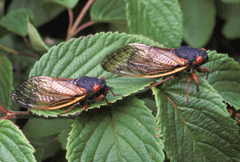
Adult Cicadas (Courtesy of USDA)
GELLERMAN: It’s been a big sleep, but now they’re wide-eyed, bushy-winged and back in droves. In northern Illinois, the 17-year cicadas are re-emerging from their long underground snooze. And commentator Tom Montgomery-Fate has been watching them in his backyard in suburban Chicago wondering whether the cicada’s short but dramatic lives offer a bit of insight into our own.
MONTGOMERY-FATE: All spring I noticed the little holes appearing in our rose bed. They are the openings to the finger-sized mud chimneys where thousands of cicada nymphs had been waiting for the moment their bodies would “know” they should leave. After 17 years of waiting in the darkness and sipping from tree roots, the moment finally arrived.
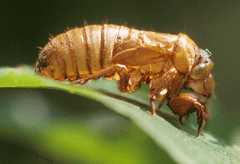
Cicada nymph (Courtesy of USDA)
This explosion of cicada - roughly a half million of them per acre—has prompted a range of emotions from my neighbors - from joy to disgust. Some are repulsed by the swarms of bugs clinging to their bushes and flowers, or falling out of trees into their hair during an evening stroll.
But others, like me, see the cicada as the genius of nature: 17 years of patience, of waiting underground, followed by a few weeks of passion, of sunlight and sex, of birthing and dying. This seeming imbalance between patience and passion is misleading. The rare abundance of the cicada evolved to overwhelm their predators, who simply can’t eat them all. The patience and passion has a purpose, and it has worked for thousands of years.

Adult Cicadas (Courtesy of USDA)
I shift my attention back to the ancient chorus in the backyard, and strain to hear something hopeful amid the cacophony, something I can trust. I try to remember that we and the cicada are related, and to believe that that matters, and that it is never too late to crawl out of the darkness into the stunning possibilities of the sunlight.
[MUSIC: Sleepytime Gorilla Museum “The 17-Year Cicada” from ‘Of Natural History’ (Web Of Mimicry – 2004)]
GELLERMAN: Tom Montgomery-Fate teaches writing at College of DuPage in Glen Ellyn, Ill. He’s the author of the memoir, “Steady and Trembling.”
Related links:
- Tom Montgomery-Fate, Professor of English, College of DuPage
- Chicago Tribune Cicada Map
- Cicada Mania website
Utah River, Frogs Bounce Back
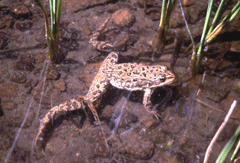
GELLERMAN: On a spring day nine years ago, then Interior Secretary Bruce Babbitt stood in Utah’s Provo River searching for a rare Columbia spotted frog.
BABBITT: (tape) We are still looking for our first frog and I intend to keep coming back to Utah until I find one.
GELLERMAN: Well, Babbitt didn’t find one that day, and we don’t know whether he ever actually made it back to the river, but the frog did, thanks in part to a deal Babbitt brokered with a bunch of federal and local agencies. It took nearly a decade to restore the spotted frog’s habitat along the Provo River. It’s one small success story at a time when other species of frogs around the world are disappearing.
Beth Hoffman has our report.
HOFFMAN: Sometimes you don’t know what you’ve been missing until an old-timer points it out to you.
HOMER: When we were kids, 10-12 years old, we’d walk through meadows and catch some of these larger frogs.
HOFFMAN: Edwin Homer is a stocky, yet fragile-looking man, with neatly combed gray hair. He is recounting stories of his days as a boy catching frogs in the “slues” outside of Coalville, Utah, his home for the last 78 years.
HOMER: We’d take them down by the river, build a fire, and skin the hind legs, and we’d have a frog fry. They was quite tasty. It had a taste of their own, and if you got a biggest one, it would kind of have a taste…
HOFFMAN: What do you think he is going to say?
HOMER: … it would resemble a little bit of a chicken.
HOFFMAN: Within Edwin Homer’s lifetime, the marshy areas he remembers playing in as a kid, changed. Rivers were dammed and channelized, and the wetlands the frogs once used for breeding became dry land for grazing cows. But now along this western river, that may be changing.
[SOUND OF THE RIVER]
HOFFMAN: The Provo runs about 20 miles outside of Park City, Utah, with a backdrop of towering snow capped mountains and busy highways, sage-covered hills and new housing developments. Wildlife biologist Paula Trater traverses the area, looking for frog egg masses – gelatinous globs about the size of a large mango holding about 400 eggs in each.

Columbia Spotted Frog (Courtesy of United States National Park Service)
TRATER: You get attached to them. Having done it for so long, they get to be like your friends. I mean I’ve planned my two children to be born around the frog season. It is just part of your life.
HOFFMAN: Trainer considers herself lucky – a biologist documenting a successful comeback story. Every year since the Restoration Project began, Trater spots more and more of the translucent eggs floating in the shallow ponds near the river.
[SOUND OF WATER]
TRATER: You can see the older ones, those have turned orange-ish, they absorb that red algae in the water. And then the fresher ones right next to it are clear, with the little black embryos.
[SOUND OF WALKING THROUGH THE WATER]
HOFFMAN: This river’s turn around is dramatic. Tyler Allred is the hydrologist that helped design the Provo Restoration project. He and partner Chad Gourley began the reconstruction in 1999, with a river that was as straight and channelized as a water ride in an amusement park.
ALLRED: In the ’50s and ’60s, the Bureau of Reclamation, had straightened it, sort of taken out all the curves. They lined with large rock so that it couldn’t move around and they built the banks up high on both sides, they put dikes there, so that it would never flood, never move.
HOFFMAN: And that’s the way the river might have remained. Except that people began to notice that the Columbia Spotted Frog, once plentiful, had all but disappeared. And so the debate between those that wanted the frog listed on the endangered species list, and those that did not, began. But Secretary of the Interior Bruce Babbitt, came up with a compromise. The frog would remain off the endangered list and development would continue in Utah, if and only if federal, state, tribal and local agencies committed to restoring the Provo River.
BABBITT: Basically it’s an attempt to say that we can have it both ways: we can develop and we can protect God’s creation.
HOFFMAN: Babbitt and other leaders met on the Provo River in 1998 to sign the deal that became one of the Interior Secretary’s hallmark compromises. And today his plan seems to be working. Paula Trater is out again in her safari hat and old fleece sweatshirt checking for eggs with hydrologist Tyler Allred.
[SOUND OF WALKING THROUGH WATER]
ALLRED: Are the frogs over here?
TRATER: They are, have you seen that?
ALLRED: No
TRATER: Man oh man! You’ve got to see it, I can’t even describe it.
ALLRED: It’s getting that good back there?
TRATER: Those little ponds have merged into one big, happy frog heaven.
HOFFMAN: The section Trainer is so excited about is one Allred and his team leveled seven years ago so that the area could safely flood. Then it looked like a moonscape, but today the river can now do what it naturally does best - change.
ALLRED: River ecosystems rely on disturbance. Without that, the system sort of stagnates, the cottonwoods that have established grow and they get older and they die and there aren’t any new one. And that process was actually the primary goal we were looking for – we wanted the river to be active, we wanted it to move around and allow those natural processes to take over.
HOFFMAN: Now a huge beaver lodge towers over the cattails of the side channel, a mass of chewed off young cottonwoods only a half-mile from the highway. Beaver dams also plug up the side-channels, which in turn creates ideal habitat for the frogs - swampy and shallow, and protected from predator fish
TRATER: Sometimes I’ll hear a woodpecker in the distance and it’ll sound just like a frog, their mating call. Like a..
[CLICKING SOUNDS]
ALLRED: Amphibians as a whole are taking a beating around the country. State wide, the numbers have been tanking. They’re kind of like the canary in the coal mine; they are the species that seems to react early when there are problems. And you can also tell when they’re doing well, that probably a lot of things in the ecosystem are doing well.
TRATER: And they are so cute…(laughing)
HOFFMAN: Nine years of cooperation and $45 million dollars seem to have paid off. Not only are the frogs back, but the trout are doing well too. So are property values. But not listing the Columbia Spotted Frog has also had repercussions. Nearby frog habitat is now home to luxury condos and golf courses. But Trater is hopeful that simply living with frogs in our midst will help change the way we understand the world around us.
TRATER: I think if this project hadn’t come on line, if it would have been going the way it was going before, another generation they wouldn’t have known they existed. I mean a world without frogs it’s a sad world. And if you don’t know it then you don’t know what you are missing. You know?
HOFFMAN: For Living on Earth, I’m Beth Hoffman in Heber, Utah.
Related links:
- Utah Reclamation, Mitigation and Conservation Commission
- State of Utah's Division of Wildlife Resources
Listener Letters
[THEME MUSIC]
[PHONE RINGING]
GELLERMAN: Hello?
FRANCITO: Good morning, I just heard your interview with Bob Kantor who makes the advertising hangers.
GELLERMAN: That’s Dan Francito, of South Wellfleet, Massachusetts, calling in response to our story about the Hanger Network company, it’s producing clothes hangers made out of recycled paper to replace ones made of steel. The new hangers may be more environmentally friendly, but they carry ads, and for Dan they’re just another source of eye pollution.
FRANCITO: I feel that he’s hiding behind concern for the environment in order to push more advertising. I liked your little comment at the end about other ways to conserve resources, just use the same hangers over and over when you go to the cleaners, etc.
GELLERMAN: And then Dan, hung up.
Our interview with Rice University professor Vicki Colvin about the coming nanotechnology revolution brought this from John Victery of Houston, Texas, who wrote in praise of Dr. Colvin:
“Everything she mentions about Nanotechnology brings promise, if not right away then certainly to those souls who will follow us.” But Michael Blackwell, who listens to us on WUVT in Blacksburg, Va., has a dimmer view of the technology. While Dr. Colvin assures us that “We can be confident that everything will work out,” he writes, “We were told the same thing about lead, PCBs, mercury, carbon dioxide, MTBE, nuclear waste, and Teflon.”
And Finally, our conversation with author Barbara Kingsolver about her new book, “Animal, Vegetable, Miracle: A Year of Food Life” had Huntley Gordon, of San Jose, California, reaching for his phone.
GORDON: I found her interview to be very, I guess revolutionary in the way she was thinking in regards to having locally grown products be part of your daily diet. I too feel that it is completely ludicrous that we could have produce imported from thousands of miles away, rather than being able to harness what we have here in the United States, and I truly embrace her project.
[THEME MUSIC]
GELLERMAN: Well, you can embrace more of the local food revolution a bit later in the show, in the mean time we’re all ears. Let us know how you feel about what you hear on Living on Earth. Drop us a line at 20 Holland Street, Somerville, Massachusetts, 02144. Or email us at comments@loe.org. Our listener line is 800-218-9-9-8-8. That's 800-218-99-88.
Just ahead colorful and nutritious new veggies are on the way, orange you glad you ate your cauliflower? You’re listening to Living on Earth.
ANNOUNCER: Support for the environmental health desk at Living on Earth comes from The Cedar Tree Foundation. Support also comes from the Richard and Rhoda Goldman Fund for coverage of population and the environment. This is Living on Earth on PRI, Public Radio, International.
Emerging Science Note/Orange Cauliflower
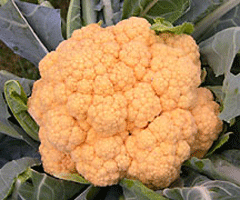
Is it a cauliflower, is it an orange or is it...both? (Courtesy of Cornell University)
GELLERMAN: It’s Living on Earth. I’m Bruce Gellerman. Coming up, getting bit by the travel bug, almost literally. First this Note on Emerging Science from Lauren Cox.
[SOUND OF SOMEONE BITING INTO A CARROT]
COX: What’s orange, crunchy, healthy and delicious? Not just the carrot anymore.
Some 30 years ago, a Canadian farmer discovered small orange cauliflower growing in his white cauliflower field. The farmer’s curiosity led to decades of cross breeding which finally brought a larger, tastier version of the orange cauliflower to supermarkets. Now, researchers at Cornell University have discovered the genetic mutation that gives the cauliflower its orange hue, and they hope to harness its nutritional value for other crops.

Is it a cauliflower, is it an orange or is it...both? (Courtesy of Cornell University)
The orange in the cauliflower – and in carrots – comes from beta-carotene. Our bodies use beta-carotene to make vitamin A, which helps our immune system and eyesight. The orange cauliflower has at least 25 times more beta-carotene than white cauliflower, and more than many staple crops. Staple crops like maize, potatoes, rice and wheat are low in beta-carotene, so people in developing countries who depend on staple crops often have a vitamin A deficiency, which is the leading cause of blindness in children.
The Cornell scientists hope to take the gene that gave the cauliflower its orange hue and insert it into staple crops to make them more nutritious. They already have an orange potato in the works.
And there are other advantages to being orange. The orange cauliflower has antioxidants that help protect the plant through stressful climate conditions. That’s this week’s note on emerging science, I’m Lauren Cox.
Intrepid Travelers
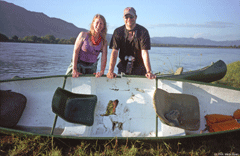
Marty and Deb after they survive a hippo overturning their canoe. Credit: Photo: Brian Worsely
GELLERMAN: The other day I took out a map of the world and thought if I could go anywhere, anywhere in the world where would I go? Well, unfortunately, I only got as far as the internet but when Marty Essen got the urge to get up and go for an adventure he got up and went and didn’t come back for the next three and a half years, during which time he hit all seven continents.
After years in a mild-mannered job Essen got bit hard by the travel bug and took off with his wife Deb. Their adventures took them off the beaten path. Along the way they had many close encounters with some of the worlds most unusual and deadliest plants and animals from poisonous stinging trees to pythons, piranhas, hippos and penguin poo.
Marty Essen chronicled his adventures in the travel award winning book “Cool Creatures, Hot Planet.” Marty Essen joins us from Missoula, Montana where he hangs his hat when he’s home. Marty, welcome.
ESSEN: Well, thank you for having me on.
GELLERMAN: You’re closing in on the big 4-0 and boy you go around the world looking for dangerous animals.
ESSEN: Well, I love dangerous animals. When I reached 39 years old and realized I hadn’t been seeing many of these animals I decided it was time to get out and have some fun.
GELLERMAN: Your book is called “Cool Creatures, Hot Planet.” What’s the coolest creature?
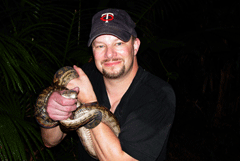
Marty with a seven-and-a-half foot Amethystine Python (Photo: Chris Leach)
GELLERMAN: You have a very close encounter with what I was told is the most dangerous animal actually in the world and that’s the hippo. And I was surprised by that.
ESSEN: Well, you know what we did for Zimbabwe, is the first part of our trip, we hiked 53 miles across Mana Pools National Park. And saw great wildlife as we went across. And then what we did is we got into canoes and headed down the Zambezi River. My wife and I are canoeing along shore, and we feel this little bump. And next thing you know my wife, and I are six feet up in the air. The hippo had come underneath us. Its lower tusks went right through the bottom of the canoe and its top jaw came over the gunwale. And then if you can imagine a front end loader lifting gravel and dumping it into a truck, that’s what the hippo did with us. It lifted us up six feet in the air and then dumped us on shore. I can still see it in slow motion as my wife hits the ground in this crumpled heap and I’m thinking, “Oh my God my wife is dead.” And I run up to her, “Deborah are you ok? Are you ok?” And we looked at each other and realized we were ok and broke into hysterical laughter. How may people get a chance to live through a hippo attack?

Marty and Deb after they survive a hippo overturning their canoe. (Photo: Brian Worsely)
ESSEN: Well, we weren’t necessarily, no we’re not looking for trouble. But sometimes it happens.
GELLERMAN: You know there’s Steve Irwin, the Crocodile Hunter, who died so terribly not too long ago. And you take many of the risks I think that he takes actually, and I’m wondering what’s the place for a person like you in this world. Is that really responsible? I guess that’s my question.
ESSEN: With Steve Irwin the Crocodile Hunter, after he died there was so much controversy with people saying well he got too close to animals. And the answer to that is yes he did get too close to animals. But you’ve got to look at the good that does. For instance, when I go to schools and I talk to students and I bring out my snakes. If I had done that anytime before the Crocodile Hunter existed I would have had people cowering in corners trying to get away because they wouldn’t want to be anywhere in a room with a snake. Yet, now these kids get all excited about the fact that they can see a snake and they want to hold the snake. The more people understand animals that aren’t necessarily warm and cuddly the more they’re going to want to protect them.
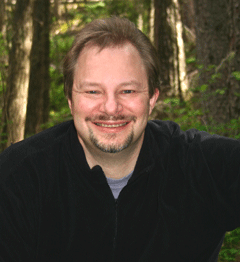
Author Marty Essen (Courtesy of Encante Press)
ESSEN: Well, yeah we had a 25 pound weight limit. When you’re a photographer like I am, that takes up half your weight. If I have to leave my underwear home I’m going to leave it. Yeah I ended up doing that whole trip without underwear because I was not leaving my camera gear at home.
GELLERMAN: Well, you came back with some great pictures.
ESSEN: Well, one of the photos that I have which is from the Amazon chapter, is a white orchid mimic spider, that I believe I’m the first person in the world to ever photograph. It’s just a bizarre looking spider.
GELLERMAN: Oh, I see him. It looks like an orchid.
ESSEN: It looks like an orchid.
GELLERMAN: On the cover of your book is a picture of you and there’s an animal over your left eye. What is that?
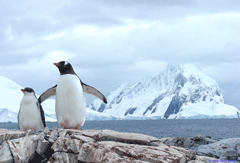
Gentoo Penguins in Antarctica (Courtesy of Marty Essen)
GELLERMAN: I hope you wore your underwear that day.
ESSEN: (laughing) Yeah, I wore my underwear that day.
GELLERMAN: Marty, thank you very much. I had a great time talking with you.
ESSEN: Well, I had a great time talking with you, Bruce.
GELLERMAN: Marty Essen’s new book is called, “Cool Creatures, Hot Planet: Exploring the Seven Continents.” You can see more of his pictures and a link to his Web page at our Web page loe dot org.
[MUSIC: Ry Cooder "Cherry Ball Blues" from 'Boomer's Story' (Reprise Records -1972)]
Related link:
Cool Creatures, Hot Planet
Eating Locally, Cooking Creatively
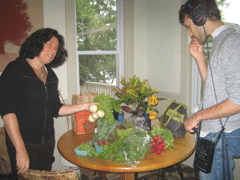
Now that it's in the kitchen, what are we going to do with it? (Photo: Amy Fish)
GELLERMAN: Pesticides, E. coli, tainted imported foods it’s enough to make you sick. These health concerns and a desire for tastier foods have a growing number of people trying to eat local.
Farmers’ markets are booming and so are farms that are supported by direct subscription—that’s a movement known as Community Supported Agriculture. At CSAs, members pay a farmer in advance of the growing season and they receive a weekly box of whatever is fresh off the farm. For CSA members it’s sort of a surprise package and part of the fun is figuring out what to do with all the locally grown goodies.
Living on Earth’s Ian Gray is a member of a CSA near Boston called Red Fire Farm. He recently made his first pick-up of the season and food writer Kathy Gunst was there to give him some ideas on how to cook the contents.
[SOUND OF FARMER’S MARKET]
GUNST: You could take a head of lettuce, a bunch of turnips, what a bunch of kale.
GRAY: Half a bag of salad greens.
GUNST: Mix and match. A pound of spinach, a bunch of scallions, cilantro or radishes. I’d vote for cilantro.
GRAY: Ok.
GUNST: And then you get strawberries and peas?
GRAY: Yup. We’ll get both of those too.
[PAPER BAG SOUND]
GUNST: What kind of lettuce do you like?
GRAY: Ah, jeeze, I don’t know. We’ve got three kinds here: romaine, iceberg…
GUNST: This red leaf looks like sculpture. I would vote for that.
GRAY: Oh, it’s dying to be picked up. Let’s grab some of that.
GUNST: Let’s take a bunch of turnips that’s not like baseball sized, more medium size. I don’t know why, when I see a root vegetable that’s big I always think it’s going to be tough. But it’s probably great. A bunch of turnips.
GRAY: I see, all right, let’s go for some of that kale over there.
GUNST: The kale. Ok, scallions.
GRAY: Ok.
GUNST: These are so beautiful. They’re pencil thin. Let me just think about what I’m going to do, and then ask you what you have at home because this is a very odd collection of food. These are not things that like, you think, “Oh, kale and turnips yum! They’ll be terrific together.”
[MUSIC: Ry Cooder "Cherry Ball Blues" from 'Boomer's Story' (Reprise Records -1972)]
GUNST: I’m thinking of roasting the turnips and doing a salad with the greens and some of the cilantro, and the roasted turnips on top. And I’m thinking about making candied walnuts to go with it, because I think that would be really yummy with the turnips.
GRAY: That sounds delicious.
GRAY: So, we’re all the way up on the third floor.
[SOUND OF DOOR OPENING]
GUNST: Ok. First thing we’re going to do is roast the turnips because they’re going to take the longest. I’m just going to trim them.
[SOUND OF CHOPPING VEGETABLES]
And they’re a little big to quarter, so I think I’m going to cut them into six wedges. I think these are going to be very sweet. And you know we should even taste it raw because I suspect this fresh…

Now that it's in the kitchen, what are we going to do with it? (Photo: Amy Fish)
GUNST: Taste that. That is really good.
GRAY: Let’s see, ok. Yeah, this is so sweet. It’s about the texture of an apple kind of.
GUNST: Yeah, it’s very crunchy and they’re this beautiful ivory-colored vegetable. So, I’m thinking to roast them and then we’ll put them on top of our salad so it will be this really nice contrast to all the greens.
[PEPPER GRINDER]
GUNST: Little grinding of fresh black pepper and I’m going to drizzle about a tablespoon and a half, two tablespoons, of olive oil. Just give them a toss so that all the turnips get coated with everything. Let’s pop these in the oven. The turnips were what, one step. So, let’s check on them in about 15 minutes.
[MUSIC: Ry Cooder "Cherry Ball Blues" from 'Boomer's Story' (Reprise Records -1972)]
GUNST: So, we have all these gorgeous greens. These are like babies. You know, this is like precious stuff. This is spring greens. So I’m just gently putting a little bit of water on it and tossing them, just to make sure there’s no grit or sand in there. And then I thought for another added crunch we bought some walnuts. And I wanted to make a honey glaze walnut topping which is a lot simpler than it sounds.
[PAN SIZZLING]
A cup and a half of walnuts, and I would say one tablespoon, two tablespoons, about a quarter of a cup of honey. And this looks like great honey. We just want to stir them around and get them all coated. I’m going to lower that a little so they don’t burn. And what happens is you get this really quick glaze. And that’s it, that’s the whole recipe.
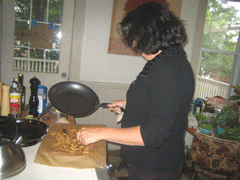
Scrumptious walnuts after they've soaked up some butter and local honey. (Photo: Amy Fish)
GRAY: And the amazing thing is that it’s not that expensive to do what we’re doing with the CSA.
GUNST: I wanted to ask you about that. How much do you spend to be a CSA member?
GRAY: So, for the season for 20 weeks of food, and each week pretty much in the summer we pick up a box, it’s 450 dollars.
GUNST: So, let’s break that down: 450 dollars, if it were 10 weeks it would be 43 dollars, so it’s about 23 dollars a week.

Turnips and salad greens...just missing the walnuts and some last minute radish slices. (Photo: Amy Fish)
GRAY: So, if you think of a household, like we’ve got 4 people here splitting this. ’Cause you know we’re just out of college and there’s 4 of us living here, so I think we’re spending each about 125 dollars for a summer of produce.
GUNST: For beautiful food. And you’re staying healthy. And you’re helping a farm. And you’re probably stretching your imagination about what you would be eating. And you’re not getting take out. So, it’s a win-win. Ok, the turnips have been in for about 15 minutes. Lets’ check them.
GRAY: Ok.
[OVEN DOOR OPENS]
GRAY: Oh, wow.
GUNST: You smell that? They’re getting really sweet.
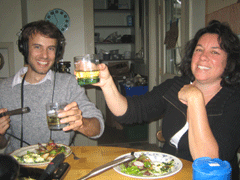
Bon Appetit! Kathy Gunst and Ian Gray dig in. (Photo: Amy Fish)
GRAY: You can smell the sugars coming out. It’s amazing.
[MUSIC: Ry Cooder "Cherry Ball Blues" from 'Boomer's Story' (Reprise Records -1972)]
GUNST: That’s exactly right. That’s exactly what you’re smelling. All right, let’s set the table.
[WINE CORK]
GRAY: Ok, well bon appetite.
GUNST: Oh, my goodness. I think I’m a fan of the turnips. Mmm taste that.
GRAY: Oh, wow.
GUNST: Yum!
GELLERMAN: Living on Earth’s Ian Gray with food writer Kathy Gunst.
[MUSIC: Ry Cooder "Taxes on the Farmer Feeds Us All" from 'Into the Purple Valley' (Reprise Records - 1972)]
Related links:
- Mixed Green, Roasted Turnip and Honey Roasted Walnut Salad Recipe
- Spinach, Scallion and Feta Frittata Recipe
- Find a Community Supported Agriculture program near you
- USDA definition of Community Supported Agriculture
- Challenge to Eat Locally
- Kathy Gunst's Website
GELLERMAN: Next time on Living on Earth, plastic trash is working its way through the food chain of the world’s oceans confusing and killing all kinds of marine creatures.
MOORE: There’s no food in the ocean that plastic can’t mimic. They assume virtually every shape, consistency and color.
GELLERMAN: The impact of plastics on the seven seas next time on Living on Earth.
GELLERMAN: You can hear our program anytime on our Web site, or get a download for your MP3 player. The address is loe dot org, that’s L-O-E dot O-R-G. You can reach us at comments@loe.org, once again comments at L-O-E dot O-R-G. Our postal address is 20 Holland Street, Somerville Massachusetts 02144. And you can call our listener line at 800-218-9988, that’s 800, 2-1-8, 99-88.
[MUSIC CONTINUES]
[SOUND: “Linnaeus’s 17-Year Cicada (Magicicada septendecim)” recorded by Lang Elliott and Wil Hershberger for ‘The Songs of Insects” (Houghton Mifflin Company/Nature Sound Studio – 2007)]
GELLERMAN: We leave you this week with the eerie chirps and drones of a once-in-a-17-year visitor.
[CICADA DRONES CONTINUE]
Linnaeus cicadas have big wings, black bodies and red eyes. You would too if you only woke up once every 17 years. Lang Elliott and Wil Hershberger recorded this chorus of creatures for their new book, “The Songs of Insects” from Houghton Mifflin.
Living on Earth is produced by the World Media Foundation. Our crew includes Ashley Ahearn, Eileen Bolinsky, Ian Gray, Ingrid Lobet, Andrea Smardon, Peter Thomson and Jeff Young - with help from Bobby Bascomb, and Kelley Cronin. Our interns are Lauren Cox and Amy Fish.
Dennis Foley is our technical director. Alison Lirish Dean composed our themes. Our Executive Producer is Steve Curwood. You can find us at LOE dot org. I’m Bruce Gellerman. See ya in 17 years fellas.
Thanks for listening.
ANNOUNCER: Funding for Living on Earth comes from the National Science Foundation, supporting coverage of emerging science; And Stonyfield Farm Organic yogurt, smoothies and milk. Ten percent of profits are donated to efforts that help protect and restore the earth. Details at Stonyfield dot com.
Support also comes from you our listeners, the Ford Foundation, the William and Flora Hewlett Foundation, and the Saunders Hotel Group of Boston's Lennox and Copley Square Hotels. Serving you and the environment while helping preserve the past and protect the future, 800-225-7676.
Support also comes from Pax World Mutual Funds—socially and environmentally sustainable investing. Pax World, for tomorrow. On the Web at paxworld dot com.
Living on Earth wants to hear from you!
Living on Earth
62 Calef Highway, Suite 212
Lee, NH 03861
Telephone: 617-287-4121
E-mail: comments@loe.org
Newsletter [Click here]
Donate to Living on Earth!
Living on Earth is an independent media program and relies entirely on contributions from listeners and institutions supporting public service. Please donate now to preserve an independent environmental voice.
NewsletterLiving on Earth offers a weekly delivery of the show's rundown to your mailbox. Sign up for our newsletter today!
 Sailors For The Sea: Be the change you want to sea.
Sailors For The Sea: Be the change you want to sea.
 The Grantham Foundation for the Protection of the Environment: Committed to protecting and improving the health of the global environment.
The Grantham Foundation for the Protection of the Environment: Committed to protecting and improving the health of the global environment.
 Contribute to Living on Earth and receive, as our gift to you, an archival print of one of Mark Seth Lender's extraordinary wildlife photographs. Follow the link to see Mark's current collection of photographs.
Contribute to Living on Earth and receive, as our gift to you, an archival print of one of Mark Seth Lender's extraordinary wildlife photographs. Follow the link to see Mark's current collection of photographs.
 Buy a signed copy of Mark Seth Lender's book Smeagull the Seagull & support Living on Earth
Buy a signed copy of Mark Seth Lender's book Smeagull the Seagull & support Living on Earth

